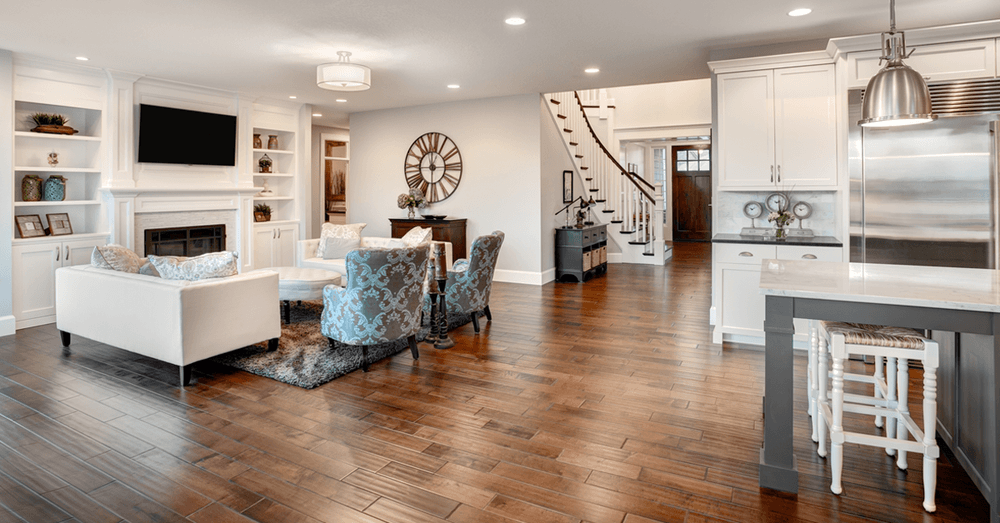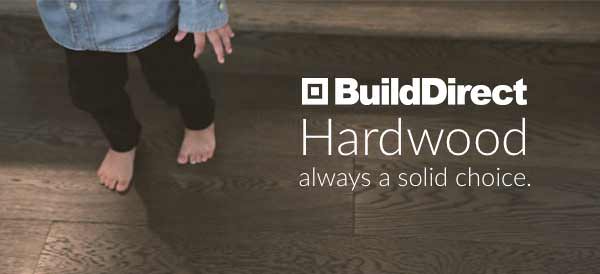Refinishing Hardwood Floors
Hardwood floors add beauty and charm to any home. Hardwood that is scratched, dented, or excessively worn can, likewise, take away from the beauty a home has to offer and even decrease its worth. It’s natural for a floor to become scuffed, marked, and worn over time. If you discover that your floor needs some additional TLC beyond normal cleaning, you’ll find that refinishing hardwood will improve the look and durability.

People choose to refinish their hardwood floors for a variety of reasons. You may decide that the color of the floor needs upgrading, especially if you’ve made other updates in the home and would like the wood to match. Floors that have seen excessive wear and tear or have large scratches or worn areas will benefit from being refinished as well. Another reason to refinish is if the hardwood floor has been covered by carpeting for a large portion of its life.
The Refinishing Process
Refinishing hardwood can be a lengthy and pricey process. This is generally not a do-it-yourself project, as there will be heavy sanders, large amounts of dust, and even hazardous chemicals. While most water based solvents are considered safe, it’s still necessary to take proper precautions for skin and lungs. Should you make any mistakes or sand too far down on the wood floor, you may need to call in a professional to help complete the task. However, that doesn’t mean you can’t benefit from understanding the refinishing process.
Prior to refinishing hardwood, The floor finish must be chosen to use. You can either choose from a water based finish or an oil based finish. Either will add longevity to your hardwood floor and help preserve it from many years to come. Oil based finishes however, are easier to work with than water based finishes. If you’re choosing to refinish a floor on your own, you may find that an oil based finish will be more user friendly.
What to Do Before Refinishing Hardwood
Before you begin, you’ll need to remove every item from the room or rooms that need refinishing. This includes wall hangings as well as the curtains or drapes from the windows. The room or rooms that will be refinished need to have a heavy duty plastic protector sheet put up across the doorway as well in order to protect the other rooms and furniture from the dust that will incur with the sanding process. Don’t forget to seal off floor vents, because dust can get down into the duct work and then be blown back up through the floor when the furnace or heating and cooling fan is started up.
Once you’ve removed the furniture and other accessories from the room, you can begin to check the floor for any damaged, cracked, or loose floor boards. You’ll want to replace these before you begin sanding. It’s better to replace them now before you begin sanding rather than have to replace them at a later date and recoat the floor or section of hardwood floor that you replaced. You’ll also want to look for exposed nails or staples in the wood floor as well. Nails and other hazards such as protruding staples can ruin your sanding equipment.
Now that your floor has been checked over, clean it thoroughly by vacuuming the floor and then going over the floor a second time with a mop and mineral spirits or other pure solution in order to remove any remaining dust and dirt. The floor must be clean and free of debris so that, when you sand and refinish, you aren’t sealing in dirt or grime. Once the floor has dried, you can begin sanding the floor.
Getting Started
There are a few things to note about safety guidelines for protecting yourself, or making sure the people who are hired to do the refinishing are properly protected. It’s important to have protective eyeglasses, ear plugs, and a dust mask to protect your lungs. Everyone who will be in the room and working on the refinishing project should have these items and wear them when needed.
In order to avoid sanding too far down into the wood, you’ll want to choose a sanding grit that won’t be too abrasive on the wood floor. Common sanding grit sizes are 60, 80, 100, and 120. You can use one or more of these to ensure that you get a smooth floor surface when you’re finished sanding.
When sanding the floor remember not to move to quickly or to push too hard on the sander. You may wind up with uneven spots on the floor. It’s also important to note that, whenever you are sanding a hardwood floor, you should go with the grain of the floor.
Once the dust has settled in the room, you can begin vacuuming up any remaining dust. Large sanding machines have attached filters with removable dust bags that are designed to catch the majority of the dust. However, it will not catch all of it. Be sure to vacuum the top of window sills, the window sill itself, and the tops of door frames. Any dust left behind will settle into your wet finish and create an unprofessional look and possibly feel gritty to the touch when it’s dried.
Applying the Finish
Strain the finish into a large bucket or garbage pail lined with a bag and let the air bubbles settle before beginning the process of applying it to the floor. Allowing the air bubbles to settle now will lessen the chance of them showing up in the wet finish, giving your floor a more polished look. Depending on the type of finish you use, choose a lamb’s wool brush or a synthetic fur brush on a long pole, similar to one used for mopping. Applying the finish should be done in a fluid motion and, once again, working with the grain.
Once the finish has dried, you can elect to put a clear sealer or polish over top for a gloss look to the hardwood floor. Often the added sealant can help protect from future scratches. However, it’s not necessary for the finished look. If done properly, your floor should be clear of scratches or any lines from brushing the finish on.
The hardwood floor may need to be refinished every five to ten years, depending on the foot traffic at home and the wear and tear. The entire refinishing process may take from a few days to a week, and throughout the process, It is necessary that the rooms being refinished are properly ventilated.
Hardwood floors add value to a home and are regaining their popularity. With some regular upkeep and proper preservation, a hardwood floor will remain durable and long outlast any carpeted floor.


mona
was wondering if i need to remove the old finish prior to using the big floor sander or if the sander removes all of that?
Priya
I am looking for Hard wood refinishing and changing the color. Please contact me as soon as possible
Carpets for Less
When you refinish the floors it’s going to be an adventure and it can get messy especially if you’re using a sander or a buffer to get them looking new again. You may also want to add some wax or stain to the floors. This can add a new color completely or enhance the color that’s already there.
Rebecca
Hi. We are in the midst of pulling up the carpet in our 80 year old home. So far the oak floors look good, but it’s in a high traffic living room with a hallway from the front entrance door to the back door. With 4 children running throughout the house, I will need something very durable that will stand the test of time. I have had 3 estimates to have this done. 2 recommend the sweedish finish, and one estimate is for the aluminum oxide fortified finish. I have been doing lots of research and feel swayed to go with the aluminum oxide finish. Will it do the job for us? I don’t know anyone who has used this finish, and all my recommendations from friends have been thrilled with the results from 3 coats of sweedish finish. Curious to get your take on it or any advice you may have. Thank you.
Frozen in indecision-
Rebecca
Sally Johnson
Thanks for the great article and great tips. My husband and I have been remodeling our home. We are wanting to install hardwood floors but learning hardfloor installation has been tricky. Great advice.
Bob the Builder
Perhaps wearing sandals with this type of machinery is not ideal.
Just saying…
linda
HELP My daughter sanded and refinished her hardwood floors she put stain on them but when she put the gloss on them her husband told her to put a very thick coat on it instead of three thin coats now it wont dry it is a mess how can they fix it?
Pingback: Frequently asked questions about hardwood (F.A.Qs) | exquisiteflooring